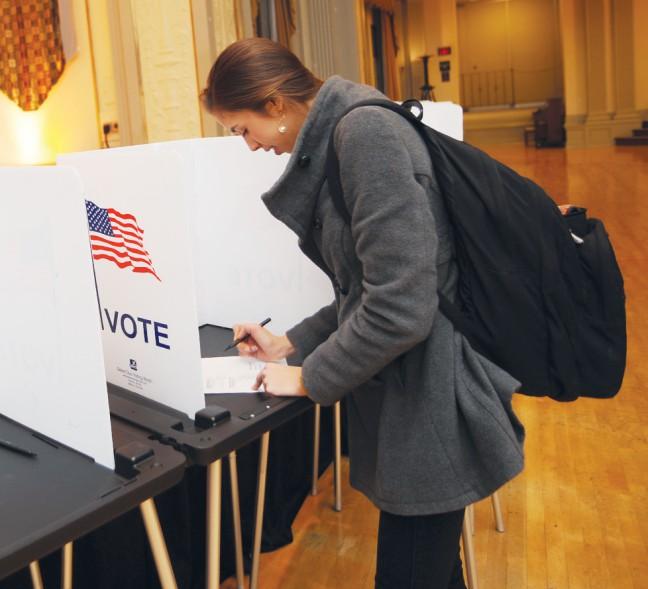Entering freshmen students are likely to appreciate any advice they can get about how to raise their first-year GPA. The key is knowing whether, where and when they should enroll in their required general education composition course, Comm A.
The tips offered here are based on course grade distribution data available on the Registrar’s website. Attention is focused on the two largest Comm A courses, English 100 and Communication Arts 100.
Tip #1. Enroll in Comm A even if you are not required to do so (many freshmen test out of the Comm A requirement). Why? Because the average fall semester grade in Comm A courses from 2009-10 through 2011-12 was 3.48, as compared to the 3.11 average for all freshmen enrolled in Letters and Science courses.
Tip #2. Enroll in English 100 rather than Communication Arts 100. Why? Because for these same three years, the average Comm A grade of 3.65 in the English Department’s course exceeded the average Comm A grade of 3.30 in the Communication Arts Department’s course.
Tip #3. Delay enrolling in Comm A until the spring semester when the average GPA is higher than in the first semester. This is true for English 100 (3.71 versus 3.65) and by a smaller margin for Comm Arts 100 (3.32 versus 3.30).
Tip #4. Delay enrolling in Comm A as long as possible to take advantage of the steady grade inflation. The average GPA in English 100 rose from 3.59 in Fall 2009-10 to 3.77 in Fall 2012; for Comm Arts 100, the average rose from 3.23 to 3.48.
These results raise two questions. First, what explains the different grading patterns in these two Comm A courses? Second, how effective are these courses in improving the ability of students to write effective prose in their subsequent courses?
In response to the first question, all one can do is speculate. It seems quite plausible that graduate student TAs in these courses are applying the same grading standard to freshman enrolled in Comm A courses as the faculty in the English and Communication Arts departments apply to them as graduate students; most of their grades are As with occasional ABs.
It also appears that these two departments apply different grading standards, unless there is independent evidence that English 100 students perform at a higher level than Comm Arts 100 students, or that English Department TAs are more effective instructors than Communication Arts Department TAs. Regrettably, no attempt seems to have been made by the two departments to develop a common grading standard for these two required courses.
What accounts for grade inflation in these courses is puzzling. From Fall 1996, when the Comm A courses were instituted, to Fall 2012, the average GPA rose from 3.20 to 3.77 in English 100 and from 3.21 to 3.48 in Communication Arts. Meanwhile, the average fall semester GPA for freshman taking Letters and Sciences courses rose from 2.93 to 3.16.
While the GPA increases are almost identical for Communications Arts 100 and Letters and Science freshmen, the increase for English 100 is twice as large. Has the English Department developed some new pedagogical approach that accounts for this widening gap between average grades in its English 100 course and in Letters and Science courses taken by freshmen?
The other question concerns the effectiveness of these two Comm A courses in improving the ability of students to write effectively in faculty-taught courses. The College of Letters and Science, which is responsible for the Comm A course, has conducted two evaluation studies of the course. The first, in 2007, appeared to be rigorous enough, but rather than assessing how well students could write, the study focused on whether students thought they had been taught the content of the syllabi for these courses. It appeared that is what they had been taught. But, this said nothing about their demonstrated ability to write.
A second study in 2012 showed that students could write somewhat better after completing the Comm A course, but the study was limited in scope. Although the student writing samples were read by carefully trained graduate student evaluators, the writing samples were not the kind that most teaching faculty would assign.
What we don’t know is how faculty members view the quality and effectiveness of undergraduate students’ ability to write in their other courses. This information could easily be obtained by surveying faculty members teaching undergraduate courses, as was done by the Committee on Undergraduate Education in 1993. The survey results led to a new two-semester composition requirement that became Comm A and Comm B.
Oh, yes, there is one more tip that concerns dollars.
Tip #5. Students operating on tight budgets might want to enroll in the course with the lowest textbook costs. The shrink-wrapped packet of materials for Comm Arts 100 is priced at $172.50 new and $132.50 used. The single book required for English 100 is priced at $32.50 new and $22.50 used.
W. Lee Hansen is a Professor Emeritus of Economics at UW.











